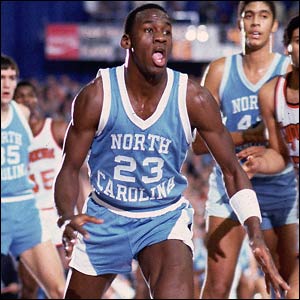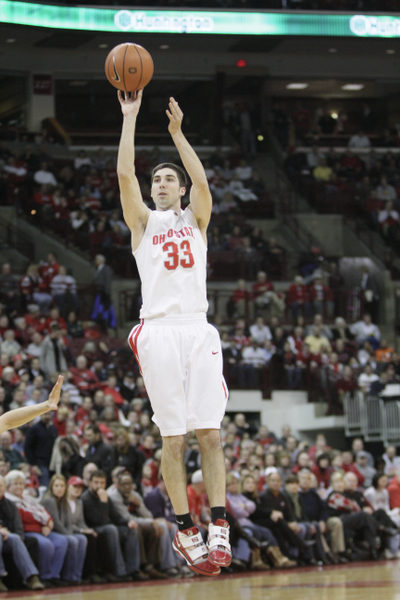Alpha Dogs, Traffic Jams, and Derrick Williams
Posted by KCarpenter on February 10th, 2011While we love to celebrate teamwork in college basketball, the truth is that the individual is much more fun. Balanced scoring is fine and tactically sound, but what we really love in college basketball is the virtuoso offensive performance, or as it is called in 2011, the Jimmer. And while the three-headed Devil from Durham may have won last season, perhaps this season, the one man show is back in style. It’s Michael Jordan’s fault, really. His competitive nature and unbelievable personal narcissism motivated him to incredible heights and made him largely unbearable to most of his contemporaries. His success provided a model for greatness that was easy to recognize and hard to argue with. There are lots of different names for the Jordan model, but Bill Simmons’ version is probably the best known: The Alpha Dog.
Simmons didn’t invent the concept or the term: lots of analysts, sportswriters, announcers and coaches have described the alpha dog model in one way or another over the years. The gist of it is this: A team needs an undisputed leader. The alpha dog is the go-to-guy on offense and is the guy who takes the game-winning shots. To win championships, you need an alpha dog. Jordan was an alpha dog (at least for the Bulls if not for North Carolina), and he is the primary reason his team won championships. Despite being a team game, you need an alpha dog to win, to demand the right to take the last shot. Guys who pass up the last shot aren’t alpha dogs: they are losers. At least, that’s the catechism. However, in the grand world of Simmon-isms, there may be another theory at play.
Specifically, I’m talking about the Ewing Theory, which in short, postulates that sometimes a team will play better without its star player, that the team will transcend the individual. Does this contradict the Alpha Dog theory? Well then it contradicts the Alpha Dog theory. Simmons, like Walt Whitman, contains multitudes. In any case, the Sports Guy has lots of examples, and anecdotally, lots of folks have seen this with their own eyes and believe it. It’s not too hard to imagine a scenario where this makes sense. The star is a volume scorer and fairly inefficient, and when the star is out of the game, the other players get more shots and more efficient shots. This is fairly intuitive and you can see the principle in action every Kentucky game. Terrence Jones is a sensational basketball player and undoubtedly incredibly skilled. That said, he is the fifth most efficient scorer on the team, but takes 30.5% of the shots. If he took fewer shots and his teammates took more, the team’s offensive efficiency would go up.
At Ohio State, Jared Sullinger uses, by far, the most possessions in each game, and for the most part, that’s fine. Sullinger is an incredibly efficient scorer with an offensive rating of 123.6 (points per hundred possessions). That said, Sullinger’s teammate Jon Diebler has an insane offensive rating of 139.1 and yet uses only 12.5% of Ohio State’s possessions. If I were to pretend you were naive here, you would then ask why Ohio State isn’t constantly feeding Jon Diebler. Fortunately, you aren’t naive and you understand that efficency is fleeting. Or if not exactly fleeting, curved.
Jon Diebler’s efficiency is so high because he takes so few shots. He is able to make so many shots because the shots he takes are shots that are relatively easy for him. He doesn’t dribble to the elbow and take pull-up fade-aways over defenders. He doesn’t take his man to the post and give him the old Dream Shake. Jon Diebler (mostly) hits open threes when he gets them. If he were to start taking more shots, the defense would key in on him, he would have to take worse shots and his offensive efficiency would plummet. So, you see, offensive efficiency exists on a curve graphed against usage. As usage increases, offensive efficiency decreases. Sure, Ohio State would probably be better served getting Diebler more shots, but the trick is that he probably can’t take too many more shots before he becomes a worse offensive option than Sullinger. The wheels start turning and strategy presents itself: what if a team really starts to take offensive efficiency to heart and has its most efficient players take as many shots as they can before they start scoring inefficiently? It seems like a pretty clever way to optimize a team’s offensive output, but it has an interesting flaw: the price of anarchy.
The price of anarchy is a game theory concept about how efficiency in a system degrades due to the self-interest of the involved actors. It has been very cleverly applied to a wide-array of situations and problems. Brian Skinner at the University of Minnesota wrote about a bewildering phenomenon that shows up in network theory fairly often: Braess’s paradox, which states that adding extra pathways to a network can sometimes slow capacity. He explained how this has been applied to traffic patterns, how by closing off major thoroughfares in Stuttgart and New York, traffic has actually been improved. It makes sense: If every car is trying to take the main expressway, the expressway becomes crowded really quickly. If, however, all the cars take a wider variety of smaller roads to get to their various destinations, travel time might actually be quicker for everyone. It didn’t take long for Brian to make the connection to the Ewing Theory and basketball.
His explanation of it, first on his blog, and then in a more formal paper and presentation at the Sloan Sports Conference, is worth a read and definitely worth your time, but it basically seeks to explain how overusing your most efficient play or player actually limits the total efficiency of the team. Now, I’m probably over my head here, but the basic gist is that simply picking the best overall strategic option and going with it until it’s no longer the best option results in a local optimization of efficiency at a Nash equilibrium, though this offensive efficiency mark may be far less than the possible global efficiency. This means that removing the most efficient option from the network and using the same tactic can result in the same overall efficiency (at the Nash equilibrium) or even a better efficiency, which would, in short, explain why the Ewing Theory works, even when the star to be removed is the team’s most efficient scorer.
What’s the take away from this? An efficient alpha dog is deadly, but an efficient team is deadlier. When Derrick Williams gets the ball, I know that he can score better than just about anyone in college basketball. When I see Arizona play, it almost seems unimaginable to do anything but get him the ball. But then I remember: addition by subtraction is a real thing and for all of his offensive brilliance, it’s best for Arizona if sometimes the not-so-sweet shooting Kyle Fogg takes a shot. The key to offensive efficiency, beyond the price of anarchy and Nash equilibriums, is patience. Derrick Williams, Kemba Walker, and the Jimmer will get just the right amount of shots in time. Every alpha dog has his day, but for the best teams, it’s never a one-man show.












































Very creative post, and a great read.
The only thing I would disagree on is the notion that alpha dogs are absolutely necessary to win championships. I’m particularly thinking of the Spurs teams of the last decade which have been more like the Duke triumvirate of last season (this might be especially true this year with an aged Tim Duncan). But the best example might be the Detroit Pistons in 2004. The ultimate team, they were.
Alpha Dogs aren’t necessary at all. The 60’s Celtics are as dominant a team as ever existed. I personally think the Alpha Dog theory is largely bunkum, but it has such traction in the popular imagination that it’s impossible to ignore. That’s the funny thing. Even if you had a super-efficient, impossibly good Alpha Dog, your team would still ultimately be better off letting me shoot my 10% from beyond the arc every once in a while.